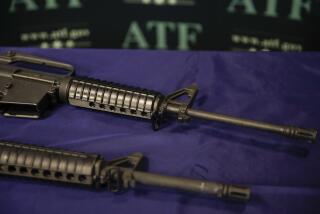Supreme Court Gives San Clemente Company ‘Trade-Dress’ Victory
- Share via
The U.S. Supreme Court gave companies more freedom to copy competitors’ designs on once-patented products in a trademark ruling Tuesday that absolved a small San Clemente road sign company from liability for its look-alike products.
The high court, in a unanimous decision written by Justice Anthony M. Kennedy, decided that a Michigan company cannot claim so-called trade-dress protection for devices that prevent road signs, like those stating “Road Work Ahead,” from falling over in high winds.
The ruling frees rival TrafFix Devices Inc., which has about $25 million in annual revenue, to sell products similar to those of Marketing Displays Inc. in Farmington Hills, Mich.
“This [decision] ought to give more comfort to those companies that try to procure a formerly patented product more cheaply, efficiently and with improvements,” said John Roberts Jr., a Washington lawyer for TrafFix.
Kennedy wrote that two expired patents on the dual-spring design that keeps the signs upright were strong evidence that the design is functional, and therefore not eligible for trade-dress protection.
Trade-dress law focuses on product design and packaging, rather than the names or logos covered under traditional trademark law. The decision by the high court narrows the scope of safeguards that a company can expect from the way products are shaped, styled or packaged.
“I think the decision represents an example of what’s common sense,” said Jon Hokanson, a Los Angeles patent and trademark lawyer. “I think, in most cases, businesses would have the view that once their patent expires, they no longer have the ability to protect designs through trade-dress protection.”
The ruling is the second from the high court in less than a year to limit trade-dress rights. Last year, the justices sided with Wal-Mart Stores Inc. in a dispute with a children’s clothing manufacturer seeking trade-dress protection for some of its products.
While a patent protects an innovative product for 14 to 17 years, a trademark is good for 20 years and can be renewed for as long as it is used. Trade-dress rules are in the trademark category.
Marketing Displays used its patented WindMaster product to gain control of most of the market from the mid-’70s until 1989, when the 17-year term on its second patent expired.
TrafFix, founded in 1987, then reverse-engineered, or copied, the device and began selling its own version, called WindBuster, in 1994. Marketing Displays sued and won at the lower court level, prompting TrafFix to appeal, eventually to the nation’s highest court.
“It’ll enable us to continue to compete legitimately in the marketplace,” said Jack Kulp, TrafFix’s owner.
Marketing Display executives and the company’s lawyer could not be reached for comment.
Kulp said his company now has grown larger than Marketing Displays, accounting for about 30% of what he estimates is a $50-million to $60-million market. The Michigan firm, he figures, now has about 18% of the market.
Once a patent expires, companies are generally free to copy its unique aspects, but many have thought twice about making similar products because they feared lawsuits over claims of violating trade-dress designs, said Roberts, the lawyer for TrafFix.
The Supreme Court’s decision may in part be a reaction to a proliferation of trade-dress lawsuits that arose after a pair of decisions in the 1990s appeared to broaden legal protections, one expert says.
“They clearly recognized that they have given companies the wrong impression that anything, any time, anywhere can be protected by trade dress,” said Joseph Dreitler, a trademark specialist with Jones, Day, Reavis & Pogue. “They’re simply trying to cut back.”
*
Bloomberg News was used in compiling this report.
More to Read
Inside the business of entertainment
The Wide Shot brings you news, analysis and insights on everything from streaming wars to production — and what it all means for the future.
You may occasionally receive promotional content from the Los Angeles Times.










